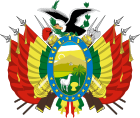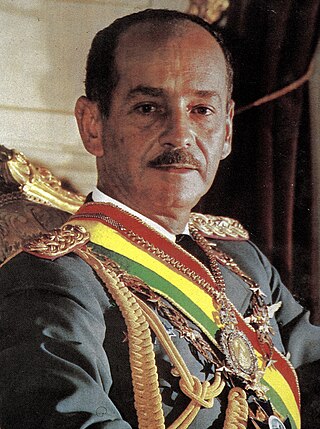 |
|---|
General elections were held in Bolivia on 4 January 1931, electing both a new President of the Republic and a new National Congress.
 |
|---|
General elections were held in Bolivia on 4 January 1931, electing both a new President of the Republic and a new National Congress.
| Candidate | Running mate | Party | Votes | % | |
|---|---|---|---|---|---|
| Daniel Salamanca Urey (PRG) | José Luis Tejada Sorzano (PL) | PRG–PL | 38,282 | 100.00 | |
| Total | 38,282 | 100.00 | |||
| Valid votes | 38,282 | 98.17 | |||
| Invalid/blank votes | 715 | 1.83 | |||
| Total votes | 38,997 | 100.00 | |||
| Source: Mesa [1] | |||||
  | ||||||
|---|---|---|---|---|---|---|
| Party | Seats | |||||
| Chamber | Senate | |||||
| Liberal Party | 26 | 10 | ||||
| Genuine Republican Party | 28 | 5 | ||||
| Socialist Republican Party | 9 | 1 | ||||
| Nationalist Party | 3 | 0 | ||||
| Independents | 2 | 0 | ||||
| Total | 68 | 16 | ||||
| Source: Political handbook of the world 1932 [2] | ||||||

José Luis Tejada Sorzano was a Bolivian lawyer, economist, and politician who served as the 34th president of Bolivia from 1934 to 1936. The last president to be a member of the Liberal Party, Tejada Sorzano previously served as the 23rd vice president of Bolivia from 1931 to 1934.

Carlos Blanco Galindo was a Bolivian general who served as the 32nd president of Bolivia on a de facto interim basis from 1930 to 1931.

José Enrique Hertzog Garaizábal was a Bolivian politician who served as the 42nd president of Bolivia from 1947 to 1949. He resigned in 1949, and died in exile in Argentina.

José María Pérez de Urdininea was a Bolivian military officer and statesman who served as the third president of Bolivia in 1828. He was the first Bolivian president to be born in Bolivia itself. He fought with the patriots against the Argentines in Peru. Despite being President for only three months, Pérez held a number of important positions in the Bolivian government including Minister of War between 1841 and 1847.

José Miguel de Velasco Franco was a Bolivian military officer and statesman who served as the fourth president of Bolivia on four occasions: 1828, 1829, 1839-1841, and 1848. Velasco also served as the second vice president from 1829 to 1835 under Andrés de Santa Cruz, though the first two of his terms were as vice president-designate, pending Santa Cruz's arrival to the country.

General elections were held in Bolivia on 1 June 1997. As no candidate for the presidency received over 50% of the vote, the National Congress was required to elect a president on 4 August. Hugo Banzer of Nationalist Democratic Action (ADN) was subsequently elected. Whilst the ADN emerged as the largest party in Congress, it failed to win a majority of seats, and formed a coalition government with the Revolutionary Left Movement, Conscience of Fatherland and the Civic Solidarity Union.

General elections were held in Bolivia on 6 June 1993. As no candidate for the presidency received over 50% of the vote, the National Congress was required to elect a president on 4 August. Gonzalo Sánchez de Lozada of the MNR-MRTKL alliance was subsequently elected unopposed.

General elections were held in Bolivia on 6 May 1951. Víctor Paz Estenssoro of the opposition Revolutionary Nationalist Movement (MNR) received the most votes in the presidential election, but as he did not obtain an absolute majority, the National Congress was constitutionally obliged to elect a President on 6 August from the three candidates who received the most public votes. However, on 16 May a military junta assumed responsibility for the Government with Brigadier General Hugo Ballivián as President.

General elections were held in Bolivia on 11 November 1934, electing both a new President of the Republic and a new National Congress, but the results were later nullified. The terms of Senators and Deputies then in office were prorogued to 5 August 1936, by Act of National Congress on 4 August 1935.
General elections were held in Bolivia on 1 December 1925, electing both a new President of the Republic.

General elections were held in Bolivia on 2 May 1925, electing a new President of the Republic. However, the results of the election were annulled.

Presidential elections were held in Bolivia on 4 May 1913, electing a new President of the Republic.
The Ministry of Government is a ministry of the Plurinational States of Bolivia. It is tasked with regulating public policy. The current Minister of Government is Eduardo del Castillo since 9 November 2020.

The Velasco III Cabinet constituted the 10th and 11th cabinets of the Bolivian Republic. It was formed on 27 March 1839, thirty-three days after José Miguel de Velasco was reinstalled as the 4th president of Bolivia following a coup d'état, succeeding the Santa Cruz Cabinet. It was dissolved on 10 June 1841 upon Velasco's overthrow in another coup d'état and was succeeded by the Cabinet of José Ballivián.

The Frías I Cabinet constituted the 33rd cabinet of the Republic of Bolivia. It was formed on 28 November 1872 after Tomás Frías was sworn in as the 17th president of Bolivia following the assassination of Agustín Morales, succeeding the Morales Cabinet. It was dissolved on 9 May 1873 upon the end of Frías' mandate and was succeeded by the Cabinet of Adolfo Ballivián.
Events in the year 1829 in Bolivia.

The Ballivián Cabinet constituted the 34th cabinet of the Republic of Bolivia. It was formed on 9 May 1873 after Adolfo Ballivián was sworn in as the 18th president of Bolivia following the 1873 general election, succeeding the First Frías Cabinet. It was dissolved on 14 February 1874 upon Ballivián's death and was succeeded by the Cabinet of Tomás Frías II.
The following is a list of events in the year 1964 in Bolivia.
The following is a list of events in the year 1982 in Bolivia.